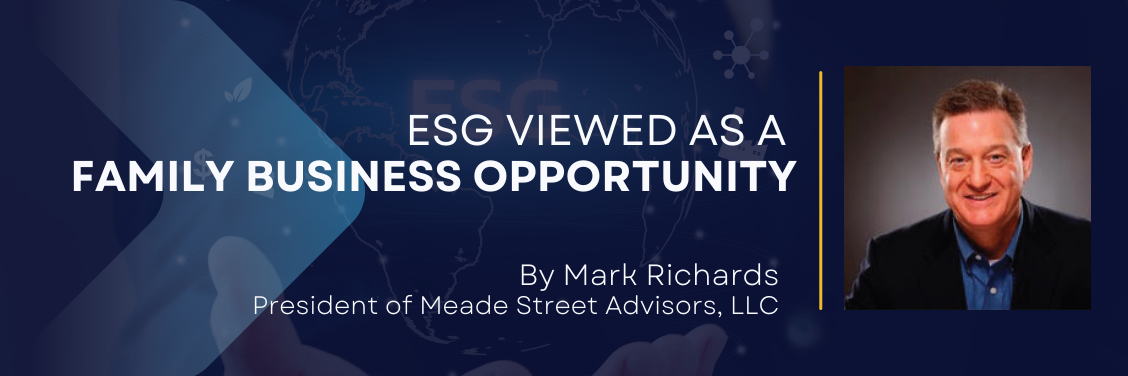
Environmental, social, and governance (ESG) topics have been around for a long time. Sustainability is ingrained in our social fabric and increasing in importance. Family businesses may wish to recast sustainability as an opportunity to improve efficiency and employee engagement. Preparing an annual business sustainability report with KPIs is one way to share the information with the board directors, management, and employees.
There are several areas where environmental data can be easily collected and monitored for improvement. For example, water and electricity consumption and pounds of solid waste are three easily measured waste streams. The business may then use this environmental data to pursue reduction initiatives, which will improve business performance. The management team can consider adding higher-order metrics in time. Examples include % of recycled input materials, energy consumption by source, air quality measurements, and energy saved by conservation.
Family businesses should consider certification programs to demonstrate their commitment to environmental stewardship. Board directors may wish to engage management on environmental matters and seek policies, procedures, and data to show progress. The board of directors realizes that family businesses with robust environmental programming will be more attractive to job seekers and certainly stand out in their community and with customers, many of whom require sustainability reports.
Social matters may be challenging for business owners and board directors because many factors come into play. Political, generational, psychological, and cultural factors compound and interfere with understanding the business implications. For that reason, management and board directors may need to “level-set” by starting with essential topics like revisiting the business mission, vision, and values. Next, the family, board directors, and management team should coalesce around this confirmed business view and refer to it when assessing social programming. For example, human resources with senior management may consider building a compelling value statement to attract talent, especially millennials. Employees want to be part of something and will seek a purpose-driven company. Well defined, frequently communicated mission, vision, and values are the starting point.
Additional social programs that may help drive productivity and retention include wellness, onsite health clinics, exercise facilities, affinity groups, leadership development, and community activism. Under my guidance as CEO, we implemented these programs over a five-year period, collected data, measured results, and reported them to the board directors. Over three years, the wellness, health clinic, and exercise facility combined to reduce the company’s self-insurance health costs.
The wellness success stories drove workplace engagement and productivity. The affinity group supported women. Today, it could be easily scaled to include other groups. Over time, trust levels increased as senior management regularly met with the affinity group. Leadership development programming rolled out over three years and ultimately reached the middle-management ranks. Community activism focused on specific areas employees felt important. Volunteerism is a powerful social program that invests employees in the community, offers leadership development, and positively reflects on the company. These types of social programs drive employee engagement, retention, and productivity. Management teams and board directors who support such programming and measure it see robust ROI.
Governance is the third leg of ESG. Forward-looking governance programming enhances company value. Family businesses with independent directors who understand, support and live the family vision and values are invaluable when focusing on essential governance functions. Strategy is where board directors need to focus their time. Management should lay out clearly defined processes with objectives and measurable goals with contingency plans. Succession planning is another focus area that applies to all employees, including family members. Here the emphasis is on understanding if management has a robust process that focuses on skills, perspectives, results, values, readiness, and self-awareness.
High-functioning boards have well-developed standing committees supporting them. Historically, the compensation committee focused on executive plans. Nowadays, it is not atypical for the compensation committee to examine all pay levels, consider how they relate to the market, and consider equity and gender issues. In addition, the use of outside compensation consultants to benchmark and demonstrate competitiveness and fairness is becoming more common in privately-owned businesses. Compensation committees should also review employee policies, codes of conduct, and programs addressing workplace bias.
Next, the audit committee performs vital work overseeing risk and financial integrity. In addition to its better-known financial, cybersecurity/IT, and insurance oversight functions, a modern audit committee will also want to ensure management has a functioning grievance hotline. Employees and other stakeholders need to know a process exists for confidentially reporting unsavory acts that undermine the business’s reputation and may put the company at risk. Another emerging area for audit is reviewing supplier chain of custody matters. It seems like overkill, but in a digital world, news travels fast. You don’t want to hear on the six o’clock news that your supplier employs child laborers.
Finally, the nominating/governance committee is integral to highly functioning boards. A nominating/governance committee drives continuous improvement. It defines expectations, the role of board education, conducts annual board performance reviews, manages board director succession, and conducts gap analysis between the future needs of the business and existing director skills and demographics.
Private companies are using ESG constructively to drive performance and more broadly define ROI. In addition, they recognize that a thought-out ESG program can attract and retain talent, especially millennials, build stronger community connections, and create more intimate customer relationships. A comprehensive ESG program permeates the entire organization and takes time to implement and optimize, making it a strategic weapon.

ABOUT MARK RICHARDS
Mark Richards is the retired Chairman and CEO of Appvion, Inc., headquartered in Appleton, WI. Mark is now President of Meade Street Advisors, LLC, board governance, executive coaching, and strategic planning consulting business headquartered in Fort Lauderdale, FL.
